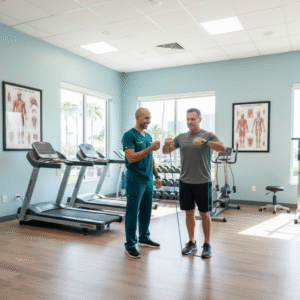Sciatica and lower back pain are two of the most common musculoskeletal conditions that affect millions of people worldwide. These conditions can significantly impact daily activities, reduce mobility, and lead to long-term discomfort if not addressed properly. While there are various treatment options available, physical therapy has proven to be one of the most effective and non-invasive methods for managing and alleviating these conditions. In this article, we’ll explore how physical therapy helps manage sciatica and lower back pain, offering long-term relief and improving overall function.
1. Understanding Sciatica and Lower Back Pain
Before delving into how physical therapy helps manage these conditions, it’s important to understand what sciatica and lower back pain entail.
- Sciatica refers to pain that radiates along the sciatic nerve, which runs from the lower back down through the hips and buttocks and into each leg. This condition often results from a herniated disk, spinal stenosis, or degenerative disc disease, putting pressure on the sciatic nerve. Symptoms include sharp, shooting pain, numbness, or tingling in the lower back and legs.
- Lower back pain is a common condition that can result from a variety of factors, such as muscle strain, poor posture, herniated discs, or spinal misalignments. It can range from mild discomfort to severe pain, affecting the lower back and potentially spreading to the hips, legs, and other parts of the body.
Both conditions can be debilitating, limiting a person’s ability to perform everyday tasks. Physical therapy provides an effective, comprehensive approach to managing both sciatica and lower back pain.
2. The Role of Physical Therapy in Managing Pain
Physical therapy for sciatica and lower back pain aims to reduce pain, improve mobility, and strengthen the muscles surrounding the spine. The goal is to address the root causes of pain and promote healing through a personalized treatment plan.
Here’s how physical therapy can help:
- Pain Reduction: Physical therapists use various modalities such as heat, ice, electrical stimulation, and ultrasound to reduce inflammation and alleviate pain. These treatments help decrease swelling, relax muscles, and promote blood flow, which can speed up recovery.
- Posture Correction: Poor posture is a common contributing factor to lower back pain. A physical therapist will assess your posture and provide exercises to improve alignment. Maintaining proper posture helps take the pressure off the spine, alleviating discomfort.
- Strengthening Exercises: Weak muscles, particularly in the core and lower back, can exacerbate pain and increase the risk of further injury. Physical therapy includes exercises aimed at strengthening these muscles to provide better support for the spine. Strengthening the muscles that surround the lumbar spine can help reduce the strain placed on it, preventing future episodes of pain.
- Flexibility and Mobility Improvement: Stiffness and limited mobility are common issues with sciatica and lower back pain. Physical therapists guide patients through stretches and range-of-motion exercises to improve flexibility. Enhanced flexibility helps reduce pressure on the spine and nerves, improving mobility and reducing pain.
3. Targeted Exercises for Sciatica Relief
Physical therapy exercises for sciatica are designed to alleviate pressure on the sciatic nerve and strengthen the muscles that support the spine. Common exercises include:
- Nerve gliding exercises: These exercises aim to gently stretch the sciatic nerve to reduce irritation and inflammation.
- Pelvic tilts: This exercise helps strengthen the lower back muscles and relieve tension in the lower spine.
- Hamstring stretches: Tight hamstrings can contribute to sciatica pain, and stretching these muscles can reduce pressure on the lower back and legs.
- Lower back strengthening exercises: Exercises such as bridges and back extensions help to strengthen the muscles around the lower back, offering better support to the spine and reducing the likelihood of sciatic pain.
By performing these targeted exercises under the guidance of a physical therapist, patients can reduce sciatica pain, improve mobility, and prevent future flare-ups.
4. Targeted Exercises for Lower Back Pain Relief
For lower back pain, physical therapy exercises focus on strengthening the core, improving flexibility, and correcting posture. Some effective exercises include:
- Core strengthening exercises: The core muscles are essential for providing support to the spine. Exercises such as planks, bird dogs, and pelvic tilts can help strengthen the abdominals and lower back muscles.
- Stretching exercises: Stretching the hip flexors, quadriceps, and hamstrings can improve flexibility and reduce strain on the lower back. These stretches help alleviate muscle tension that may contribute to pain.
- Stabilization exercises: These exercises focus on improving the stability of the spine, helping to support the lower back during everyday activities. They involve strengthening the muscles that support the spine and pelvis.
- McKenzie Method: This technique focuses on specific movements and postures that aim to reduce pain by promoting natural spinal alignment. A trained physical therapist will guide you through these techniques.
5. Preventing Future Pain and Injury
Physical therapy isn’t just about treating current pain; it also focuses on preventing future injuries and flare-ups. A physical therapist will teach you proper body mechanics and movement patterns to avoid putting unnecessary strain on your back and spine. You’ll learn how to lift, bend, and twist correctly, which can help prevent re-injury.
Additionally, therapists often provide guidance on ergonomic improvements for your home or workplace, helping you create an environment that supports a healthy spine. Proper seating, desk height, and posture adjustments can make a significant difference in managing and preventing back pain.
6. Benefits of Physical Therapy for Long-Term Relief
Physical therapy offers several long-term benefits for individuals with sciatica or lower back pain, including:
- Non-invasive treatment: Physical therapy is a non-surgical, drug-free way to manage and treat pain, making it an ideal option for individuals seeking a natural solution.
- Personalized care: Physical therapists create customized treatment plans based on each patient’s unique needs and conditions, ensuring the best possible outcome.
- Improved quality of life: By alleviating pain and improving mobility, physical therapy helps individuals return to their daily activities with greater ease and less discomfort.
- Preventative care: Physical therapy not only treats current pain but also helps prevent future episodes by improving strength, flexibility, and posture.
Conclusion
Physical therapy is an effective and non-invasive approach for managing sciatica and lower back pain. Through targeted exercises, posture correction, and pain management techniques, physical therapy helps reduce pain, improve mobility, and strengthen the muscles that support the spine. If you are struggling with sciatica or lower back pain, consulting a physical therapist can provide long-term relief and prevent future injuries, allowing you to regain a pain-free, active lifestyle.






